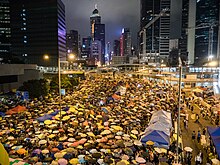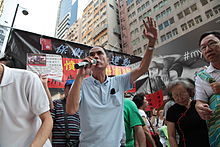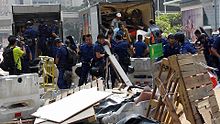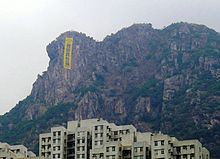Protests in Hong Kong 2014

The protests in Hong Kong 2014 ( Chinese 二零 一 四 香港 示威 , Pinyin Èrlíngyīsì Xiānggǎng Shìwēi , Jyutping Ji 6 ling 4 jat 1 sei 3 Hoeng 1 gong 2 Si 6 wai 1 ) were a series of demonstrations in the Chinese Special Administrative Region of Hong Kong that took place until Lasted in mid-December 2014.
The protests opposed a resolution passed by the National People's Congress in Beijing at the end of August 2014 , which is colloquially known in Chinese as the “ 831 resolution ” ( 8 · 31 決定 / 8 · 31 决定 , bā sānyī juédìng , Jyutping baat 3 saam 1 jat 1 kyut 3 ding 6 - "decision of August 31") is called, according to the future, a 1,200-strong, the Chinese government formed Committee, the candidates for the election of Hong Kong's chief administrators ( English Chief Executive ) sets before the people of Hong Kong over the people can vote.
The participants in the protests either demanded free elections or at least the preservation of the previous regulation. They occupied parts of the financial and administrative districts of Central and Admiralty and blocked access to the seat of government. Smaller groups also occupy parts of Mongkok and Causeway Bay .
Designations

The wave of protests was often referred to in the media as the “ umbrella revolution ” ( 雨傘 革命 , yǔsén gémìng , Jyutping jyu 5 saan 3 gaap 3 ming 6 , English Umbrella Revolution ) or “ Occupy Central ” ( 佔領 中 環 / 占领 中 环 , Zhànlǐng Zhōnghuán , Jyutping Zim 3 ling 5 Zung 1 waan 4 , short: 佔 中 / 占 中 , Zhànzhōng , Jyutping Zim 3 zung 1 ). However, the designation as " revolution " was rejected by the demonstrators. They stressed that their movement was not about a revolution, but about a demand for free elections. Some are also concerned about the aggressive undertone of the term and the provocation it has given the Beijing government. Instead, they called themselves the " umbrella movement " ( 雨傘 運動 / 雨傘 运动 , yǔsǎn yùndòng , Jyutping jyu 5 saan 3 wan 6 dong 6 , English Umbrella Movement ). The background for the term is the widespread use of umbrellas on the protest marches in order to protect themselves against sun and rain on the one hand, but also against the police use of pepper spray against the demonstrators, on around September 27th and 28th, 2014. From this the (mostly yellow) umbrella developed into a symbol of the protests.
The term “ polite revolution ” (the “polite” or “good” revolution) was also occasionally used, although this term mostly only appears in the non-Chinese-language press. This was justified with the courtesy of the demonstrators towards other demonstrators, bystanders and also police officers, and the fact that they disposed of their rubbish after the protests.
The further name " Occupy Central " is the general name for the occupation of the financial and government districts in the Central and Western district . The term is the most widely used term for the protests on the Internet portal Twitter and is based on the American Occupy movement.
background
The Sino-British Joint Declaration on Hong Kong , signed between the People's Republic of China and the United Kingdom on December 19, 1984 , set out how the city would be administered after reintegration. According to the principle of one country, two systems agreed between Great Britain and China, Hong Kong was granted the status of a Special Administrative Region in which the city has a high degree of autonomy.
When it was returned to China in 1997, the citizens of Hong Kong were offered free elections in 2017, which they were unable to do even under British rule. Until then, since 1997, every five years, Hong Kong election committees, which have been criticized for years for their composition and the dominance of business people loyal to Beijing, have elected the head of administration.
Driving forces and demands
The three main groups behind the protests were the civil rights movement Occupy Central with Love and Peace , the Hong Kong Federation of Students (HKFS) and the high school student activist group Scholarism . Although these groups led the protests together, they had different demands.
The movement Occupy Central with Love and Peace around the law professor Benny Tai and the hedge fund manager Edward Chin , which is formed by university lecturers and other intellectuals, is considered the initiator of the protest movement to occupy Central. The original plan was to begin the occupation of Central on October 1, but this was brought forward a few days to take advantage of the political mood that emerged after student protesters were attacked with pepper spray and arrested by police. Occupy Central's first demand was to get the government to withdraw the resolution passed by the National People's Congress in Beijing at the end of August. The second goal was to demand that the government in Hong Kong introduce political reforms in the direction of further democratization and revise the report on political reforms already available on this.
The two groups of students had similar goals. The Hong Kong Federation of Students , led by Alex Chow , and Scholarism , led by Joshua Wong , called for the free direct election of the next local head of government in 2017 and the resignation of the current incumbent Leung Chun-ying .
Origin and course of the mass protests
After the resolution of the National People's Congress in Beijing at the end of August only provided for limited free elections for Hong Kong 2017, there was student protests on September 22, 2014, led by Scholarism and HKUSU , in which pupils and students were called to boycott classes. Around 5,000 schoolchildren and students protested illegally in front of the Hong Kong seat of government. On the evening of September 26, around 100 people stormed Civic Square , a public square adjacent to the seat of government and closed for months near Tim Mei Avenue. When the square was cleared, up to 78 people were arrested for trespassing on government property, disrupting the peace and quiet and gathering, including the use of pepper spray. Hong Kong Legislative Council Representative Leung Kwok-hung was among those arrested . After the civil rights movement Occupy Central with Love and Peace joined the student protests on the night of September 28, this culminated in the Hong Kong protests.

The police blocked the access roads to Tim Mei Avenue and the leaders of the protest movement called for a rally in the Admiralty district . The police then positioned themselves here as well and, after only a very short advance warning, used massive amounts of tear gas against the demonstrators. The use of tear gas against illegal but peaceful demonstrators motivated many other people to join the protesters. The number of demonstrators multiplied in the following days and was estimated by Western journalists to peak at 80,000 to over 100,000. On September 28, 2014, several places (next to parts of Admiralty, Causeway Bay , Mongkok ) in Hong Kong were confiscated by the demonstrators. After the tear gas operation in the Admiralty quarter, the police were also exposed to internal criticism and in the following time tried to be more moderate and to talk to the demonstrators. After the use of pepper spray and irritant gas, many demonstrators used umbrellas as a defense and the umbrella became a symbol of the movement.
The following public spaces or quarters or parts thereof were temporarily occupied:
- Admiralty (September 26 - December 11, 2014)
- Causeway Bay (September 28 - December 15, 2014)
- Mongkok (September 28th - November 27th 2014)
- Tsim Sha Tsui (October 1-3, 2014).
On October 1, 2014, Joshua Wong and other Scholarism members attended the official flag-raising ceremony on the occasion of the national holiday in Golden Bauhinia Square. When the flag of the People's Republic of China was hoisted, all of the student representatives demonstratively turned their backs on it and made other gestures of silent protest.

On October 3 and 4, 2014, there were several counter-demonstrations against the Occupy or "umbrella" demonstrators and clashes at Mongkok and Causeway Bay. The counter-demonstrators, some of whom wore blue ribbons as identification, attacked the demonstrators and tore down tents and barricades. Individual representatives of the protest movement accused the government of mobilizing criminal triads against the demonstrators. On October 5, 2014, leading intellectuals in Hong Kong, including well-known sympathizers of the democratization movement, called on the demonstrators to end the occupations, otherwise massive police operations were to be feared. However, neither of these happened.
From October 12-14, 2014, the police began clearing some small unmanned barricades to ease the flow of traffic. On October 13, 2014, hundreds of counter-demonstrators tried to remove the barricands erected by the demonstrators. The police eventually separated the demonstrators and counter-demonstrators to prevent violence. The ranks of the demonstrators suggested that the counter-demonstrators, which consisted of "residents of the New Territories , Beijing supporters, triads and taxi drivers", were being controlled centrally by an unknown hand because they proceeded in such a coordinated manner.

The evacuation of occupied Mongkok by the police on October 17, 2014 was unsuccessful because the demonstrators reoccupied the area that was initially evacuated.
On October 23, 2014, mountain sports enthusiasts climbed the Lion Rock and unfurled a huge yellow banner with the umbrella logo and the inscription " 我 要 真 普選 -" I want a real universal right to vote "". The banner was removed the following day at the behest of the Hong Kong government. During October there were repeated discussions between Hong Kong government officials and representatives of the Hong Kong Federation of Students (HKFS). Representatives of taxi, minibus and bus companies, whose businesses were severely affected by the blockades, filed lawsuits. On November 10, 2014, the Supreme Court of the Hong Kong ( English “The High Court of the Hong Kong” , 香港 diesen ) granted these complaints, thereby authorizing the eviction of the occupied places.
At the end of October and beginning of November 2014, the "Alliance for Peace and Democracy" ( 保 普選 保 和平 大 聯盟 / 保 普选 保 和平 大 联盟 , English Alliance for Peace and Democracy ) , founded on July 3, 2014 as a counter-organization to Occupy , collected according to its own statements 1.8 million signatures for a petition calling for the restoration of law and order and an end to the occupations. The validity of this collection was questioned by the demonstrators.
As public support for the week-long occupation gradually waned, police cleared the barricades and tents in Mongkok on November 25 and 26, 2014. After the eviction, demonstrators streamed again and police and demonstrators faced each other for a while, with the police again using pepper spray. More than 100 people were arrested, but most of them were released on condition that they would not be allowed to enter Mongkok in the near future.
On December 3, 2014, 65 activists from Occupy Central with Love and Peace (OCLP) went to the police and declared that they were responsible for the protests and that they would take legal responsibility. However, after brief interrogation, they were not arrested or charged. The day before, several prominent OCLP activists had publicly called on the demonstrators to end their occupations and to steer the movement into legal channels. This was rejected by the activists of the HKFS and Scholarism, but the vigor noticeably slackened and by December 15, 2014 the still occupied places in Admiralty and Causeway Bay were largely vacated without resistance.
- Artistic adaptations of the umbrella motif
Later developments and convictions
On July 21, 2016, Joshua Wong was found guilty together with Alex Chow and Nathan Law as the responsible leaders of the large demonstrations in 2014. A Hong Kong court overturned the verdict in August 2017, sentencing Wong and Chow to six and seven months' imprisonment, respectively. Law received an eight month sentence.
See also
Web links
Individual evidence
- ↑ a b Markus Ackeret: Popular election in a tight corset. In: Neue Zürcher Zeitung . August 31, 2014, accessed October 3, 2014 .
- ↑ a b Erning Zhu: What does "Occupy-Central" want? In: Deutsche Welle. September 29, 2014, accessed October 3, 2014 .
- ↑ a b The Washington Post - Hong Kong's students want you to stop calling their protest a 'revolution'. Retrieved October 7, 2014 .
- ^ A b South China Moring Post - Beijing's rallying cry to Hong Kong… and 1.3 billion mainlanders. Retrieved October 7, 2014 .
- ↑ China Daily - It is not a revolution. Retrieved October 7, 2014 .
- ^ TIME - Hong Kong Protest Leaders Urge Reform, Not Revolution. Retrieved October 7, 2014 .
- ↑ USA Today - Standoff in Hong Kong on China's National Day. Retrieved October 7, 2014 .
- ↑ vocative - Hong Kong Locals Want Streets Cleared of "Polite" protesters. Archived from the original on October 6, 2014 ; accessed on October 7, 2014 .
- ^ The Guardian - Hong Kong pro-democracy protesters clash with pro-government supporters on streets - video. Retrieved October 8, 2014 .
- ↑ NBC News - Gun-Toting Cops Return to Hong Kong's Pro-Democracy Protests. Retrieved October 8, 2014 .
- ^ South China Morning Post - Umbrella Revolution: more designs on Hong Kong's protest movement. Retrieved October 8, 2014 .
- ↑ NewsCentered - Very Civil Disobedience: Inside Hong Kong's Polite 'Revolution'. Retrieved October 7, 2014 .
- ↑ Better name for #UmbrellaRevolution might be #PoliteRevolution. Protesters exceedingly nice, giving food, water. Retrieved October 7, 2014 .
- ↑ vocative - Hong Kong Locals Want Streets Cleared of "Polite" protesters. Archived from the original on October 6, 2014 ; accessed on October 7, 2014 .
- ↑ DIS Magazine - How the Umbrella 'Revolution' meme hurt the movement in Hong Kong. Retrieved October 8, 2014 .
- ↑ Hong Kong's democracy debate. In: BBC. October 3, 2014, accessed September 28, 2014 .
- ↑ Frank Sieren : Own goal. In: Deutsche Welle. June 30, 2014, accessed October 3, 2014 .
- ↑ Hong Kong's election campaign without the electorate. In: Neue Zürcher Zeitung . March 23, 2012, accessed October 3, 2014 .
- ↑ a b TIME - 6 Questions You Might Have About Hong Kong's Umbrella Revolution. Retrieved October 9, 2014 .
- ↑ Students block access to government headquarters. In: The world. October 2, 2014, accessed October 2, 2014 .
- ↑ Hong Kong fears for a position as a financial metropolis. In: Handelsblatt . October 2, 2014, accessed October 3, 2014 .
- ↑ NWZ Online - 17-year-old scares Beijing. Retrieved October 8, 2014 .
- ↑ Die Zeit: Hong Kong's future is decided on the street. Retrieved October 15, 2014 .
- ↑ Business Insider: REPORT: Hong Kong's 17-Year-Old 'Extremist' Student Leader Arrested During Massive Democracy Protest. Retrieved October 15, 2014 .
- ↑ USA Today: Meet the 17-year-old face of Hong Kong's protests. Retrieved October 15, 2014 .
- ^ Occupy Central won't start early, says Benny Tai, after student clashes with police leave dozens injured. South China Morning Post, September 26, 2014, accessed December 18, 2016 .
- ↑ Enda Curran: Hong Kong Police Use of Tear Gas on Pro-Democracy Protesters Is Questioned. The Wall Street Journal, September 29, 2014, accessed December 18, 2016 .
- ↑ Hong Kong: Protesters defiant amid stand-off. BBC News, September 29, 2014, accessed December 18, 2016 .
- ↑ Simon Parry: Hong Kong protests spread as 80,000 take to streets. The Telegraph, September 29, 2014, accessed December 18, 2016 .
- ↑ Thousands denounce HSBC board member's likening of Hong Kong people to freed slaves. Reuters, October 31, 2014, accessed December 18, 2016 .
- ^ Adam Taylor: Hong Kong's crossed arms and other protest gestures around the world. The Washington Post, October 2, 2014, accessed December 18, 2016 .
- ↑ Chris Buckley, Austin Ramzy, Edward Wong: Violence Erupts in Hong Kong as Protesters Are Assaulted. In: The New York Times. October 3, 2014, accessed December 18, 2016 .
- ^ Tania Branigan, David Batty and agency reports: Hong Kong legislator says government using triads against protesters. The Guardian, October 4, 2014, accessed December 18, 2016 .
- ↑ "Blue ribbons" attacks Peaceful protesters. YouTube, October 4, 2014, accessed December 18, 2016 .
- ^ Legal and political heavyweights unite in call for end to protests. South China Morning Post, October 12, 2014, accessed December 18, 2016 .
- ^ Alfred Liu, Jasmine Ng: Hong Kong Students Ready Return of Police With Chain Saws. Bloomber.com, October 14, 2014, accessed December 18, 2016 .
- ↑ Jonathan Kaiman: Hong Kong pro-democracy activists reinforce barricades at protest site. The Guardian, October 13, 2014, accessed December 18, 2016 .
- ^ Fiona Law, Isabella Steger, Kathy Chu: Protesters, Police Clash in Hong Kong's Mong Kok District. The Washington Post, October 17, 2014, accessed December 18, 2016 .
- ↑ 「香港 蜘蛛 仔」: 獅子山 上 的 海闊天空 Up on the Lion Rock: Behind the Scene !! YouTube video of the climbing action, October 23, 2014, accessed on December 18, 2016 .
- ↑ Petition against democracy movement in Hong Kong collects more than 1.8 million signatures. The Straits Times, November 4, 2014, accessed December 18, 2016 .
- ↑ Tania Branigan: Hong Kong student leaders arrested as police try to clear protest zone. The Guardian, November 26, 2014, accessed December 18, 2016 .
- ↑ Police let Occupy organizers walk away without charge after they turn themselves in. South China Morning Post, December 3, 2014, accessed December 18, 2016 .
- ^ Benny Tai, Yiu-ting, Chan Kin-man, Chu Yiu-ming: Occupy Central Trio's Letter to the Hong Kong People. December 2, 2014, accessed December 18, 2016 .
- ^ Police clear final Hong Kong protest site at Causeway Bay. BBC News, December 15, 2014, accessed December 18, 2016 .
- ^ Democracy movement in Hong Kong: leader of the protests found guilty. tagesschau.de, July 21, 2016; accessed on July 21, 2016.
- ↑ "Hong Kong: Prison Terms for Democracy Activists - SPIEGEL ONLINE". August 17, 2017; Retrieved on August 17, 2017. http://www.spiegel.de/politik/ausland/hongkong-gericht-veretzungt-demokratie-aktivisten-zu-haftstrafen-a-1163285.html .





